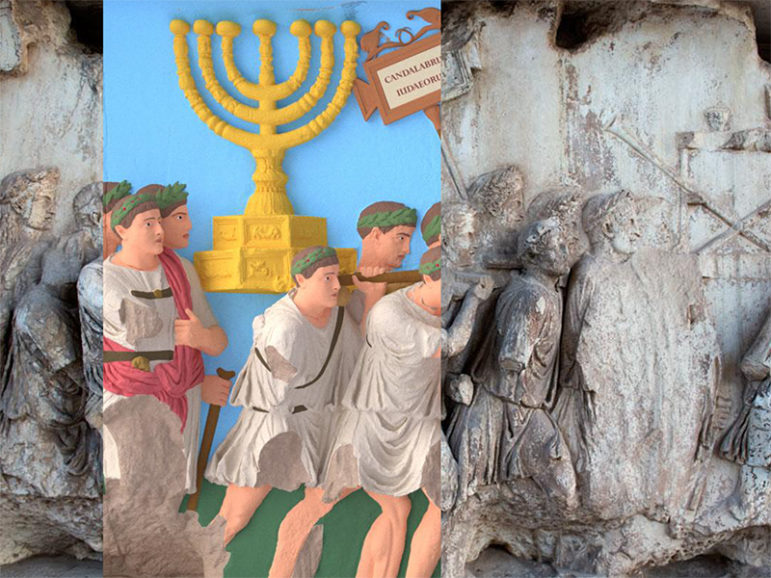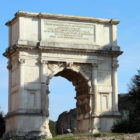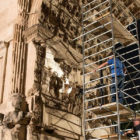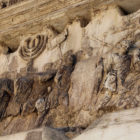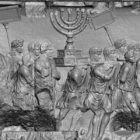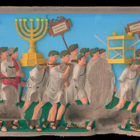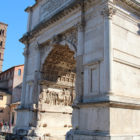ROME (RNS) It’s one of the most enduring symbols of the Roman conquest of Jerusalem nearly 2,000 years ago, and millions of tourists are drawn to see it in Rome every year.
The Arch of Titus, a marble monument in the heart of the Roman Forum, commemorates the general and later emperor Titus’ triumph over the Jews in 70 A.D. It also recalls one of the most dramatic events in Jewish history, the sacking of the Second Temple of Jerusalem, which is still mourned by Jews every year during the Tisha B’av fast.
[ad number=“1”]
The white marble monument depicts the Romans’ victory procession with spoils including a menorah, the sacred seven-branched candelabra used in the Jerusalem temple, and a ceremonial showbread table removed from the shrine.
But Steven Fine, professor and cultural historian at New York’s Yeshiva University, said the arch as it stands today is a washed-out version of the original.
- The Arch of Titus, a marble monument in the heart of the Roman Forum, commemorates the general and later emperor Titus’ triumph over the Jews in 70 A.D. RNS photo by Josephine McKenna
- A team of experts scans areas of the Arch of Titus for traces of color, using ultraviolet spectrometry to measure wavelengths of reflected light, and identifies minute traces of paint before using laser technology to create a detailed 3-D version of the panel. Photo courtesy of Yeshiva University, Arch of Titus Project
- The Arch of Titus scene commemorates the victory parade that took place after the Romans destroyed Jerusalem and sacked the Temple in 70 A.D., in one of the decisive events of the First Jewish War (66-74 A.D.). RNS photo by Josephine McKenna
- Arch of Titus panel showing the victory parade after the Romans destroyed Jerusalem and sacked the Temple in 70 A.D. Image courtesy of Yeshiva University, Arch of Titus Project
- Experts have used state-of-the-art technology to re-create the original colors of the ancient Roman Arch of Titus. Built in honor of the general and later emperor Titus, it is one of the features in the Roman Forum and commemorates the Roman conquest of Jerusalem during the First Jewish War (66-74 A.D.). Image courtesy of the Institute for the Visualization of History Inc.
- The Arch of Titus, a marble monument in the heart of the Roman Forum, commemorates the general and later emperor Titus’ triumph over the Jews in 70 A.D. RNS photo by Josephine McKenna
In 2012 Fine set to work with an international team of scientists, art historians and other experts, including Peter J. Schertz from the Virginia Museum of Fine Arts and Donald H. Sanders from the Institute for the Visualization of History in Massachusetts, to identify the arch’s true colors.
They scrutinized the monument’s sculptured details and for the first time used state-of-the-art technology to colorize its famous panel in the way it once was.
“Viewing the colored panel, one can imagine the vibrancy of the triumphal parade that had taken place a decade before the arch was built,” said Fine, professor of Jewish history and director of Yeshiva’s Center for Israel Studies.
[ad number=“2”]
“Through technology, we can imagine the original colors of the arch – and of the Jewish war itself – before they began to fade away into the grays and shadows of historical memory.”
Schertz stressed that the team’s use of color was “a hypothetical and extremely speculative reconstruction” that he hoped would lead to further study.
Fine said few people realize that ancient Rome was a virtual “carousel of color” and not the bland white stone that we see among so many ancient ruins today. Laser lighting was recently used to show how Rome’s Ara Pacis or Altar of Peace monument looked when it was unveiled in a blaze of color in 9 BC, and marble statues were usually painted in ancient times.
In partnership with Rome’s cultural superintendency, the team traveled to the Roman Forum and found traces of yellow paint on the menorah in the monument relief.
“The only piece of color we had was the yellow on the menorah, which was not a surprise because the Bible describes it as a golden lampstand,” Fine said.
The academics scanned deeply carved areas of the monument for traces of color, using ultraviolet spectrometry to measure wavelengths of reflected light, and identified minute traces of paint before using laser technology to create a detailed 3-D model of the panel.
“We began reconstructing selected elements of the arch spoils relief,” said Fine. “Once we brought in the 3-D scan data of the panel, we could manipulate it, zoom in and see it from angles that you can’t see even when close up.”
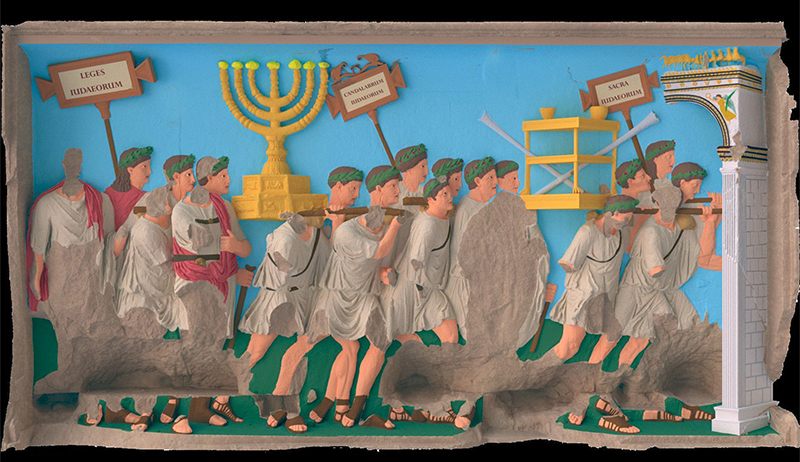
Experts have used state-of-the-art technology to re-create the original colors of the ancient Roman Arch of Titus. Built in honor of the general and later emperor Titus, it is one of the features in the Roman Forum and commemorates the Roman conquest of Jerusalem during the First Jewish War (66-74 A.D.). Image courtesy of the Institute for the Visualization of History Inc.
In their re-creation, the menorah is colored a vibrant yellow and borne by soldiers in cream linen tunics wearing green wreaths on their heads.
“Scholars of our generation, reared on the transition from black-and-white to color television, have rediscovered the true colors of the ancient world,” said the historian.
Drawing on observations and terminology used by the ancient Jewish Roman historian Flavius Josephus, Fine and his colleagues also added Latin text to the signs in the panel.
[ad number=“3”]
One reads “Sacra Iudaeorum” (“Holy Objects of the Jews”), the second reads “Candalabrum Iudaeorum” (“Lampstand of the Jews”) and the third “Leges Iudaeorum” (“Laws of the Jews”— meaning a scroll of the Pentateuch).
Fine said the monument is a potent symbol in Jewish history. It first demonstrated the power of the Roman Empire and was later used by the Catholic Church to symbolize the victory of the church and its dominance over the Jews.
“For Jews, it was often a painful reminder of their exile and continued servile status,” said Fine, who added that the arch menorah was chosen as a symbol of modern Israel in 1949.
